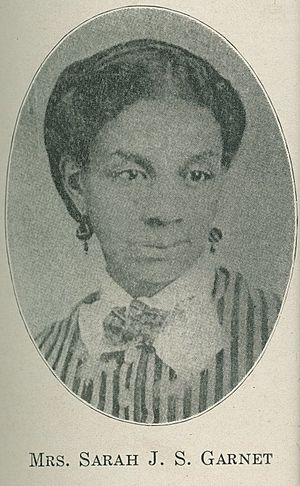Sarah J. Garnet facts for kids
Quick facts for kids
Sarah J. Garnet
|
|
|---|---|
 |
|
| Born |
Sarah Smith
July 31, 1831 Brooklyn, New York, US
|
| Died | September 17, 1911 (aged 80) New York, US
|
| Occupation | Educator and suffragist |
Sarah J. Tompkins Garnet (born Sarah Smith) was an important American teacher and a leader for women's right to vote. She lived from 1831 to 1911. Sarah was a groundbreaking African-American woman who became a school principal in the New York City public school system.
Family and Early Life
Sarah J. Smith was born on July 31, 1831, in Brooklyn, New York. Her parents were Sylvanus and Anne Smith. Sarah was the oldest of 11 children. Her parents were farmers and owned land in Long Island.
Sarah's sister, Susan McKinney Steward, was also very accomplished. She was the first African-American woman in New York State to become a doctor. She was also the third African-American woman in the entire United States to earn a medical degree.
Sarah married Samuel Tompkins, but he passed away around 1852. They had a daughter named Serena Jane Tompkins. Serena became a talented pianist and organist. She died in 1898 when she was 47 years old.
A Pioneer Educator
When Sarah Garnet started teaching in New York City, public schools were separated by race. This meant Black students and white students went to different schools.
Sarah began teaching in 1854 at the African Free School in Williamsburg, Brooklyn. At that time, Brooklyn was a large city. It wasn't joined with New York City (which was just Manhattan and the Bronx back then) until 1898.
In 1863, the principal of Colored School No. 7 in Manhattan passed away. Sarah Tompkins was chosen to be the new principal that spring. Around 1866, the school was renamed Colored School No. 4. Many important students learned from her, including the musician Walter F. Craig.
Sarah Garnet stopped working in schools in 1900. She had been a teacher and principal for 37 years.
Fighting for Women's Rights
Sarah was a strong supporter of women's right to vote. This movement is called "suffrage."
She started an organization in Brooklyn called the Equal Suffrage League in the late 1880s. She also worked as the superintendent of suffrage for the National Association of Colored Women.
Later Life and Legacy
Sarah owned a shop where she worked as a seamstress in Brooklyn. She ran this business from 1883 until 1911.
On December 28, 1875, Sarah Tompkins married a famous leader against slavery named Henry Highland Garnet. After this, she was known as Sarah Garnet. Their wedding in Brooklyn was performed by a minister named Amos Noë Freeman. He was known for helping people escape slavery on the Underground Railroad.
In 1881, President James A. Garfield chose Henry Highland Garnet to be an ambassador in Liberia. Sarah did not go with him on this trip. Henry became sick soon after arriving and passed away in 1882.
In 1911, Sarah Garnet traveled to London, England, with her sister Susan McKinney Steward. They went to a big meeting called the Universal Races Congress. At this meeting, her sister Susan gave a speech about "Colored American Women." The famous writer and activist W. E. B. Du Bois also attended this conference.
Soon after they returned from Europe, Sarah passed away at her home on September 17, 1911. She is buried in Green-Wood Cemetery in Brooklyn.
Sarah Garnet's legacy continues today. In 2019, a school called the Teunis G. Bergen School was renamed the Sarah Smith Garnet Public School 9. This happened because people wanted to remove the name of the Bergen Family, who had owned slaves. Many students at the school are African-American.
In 2021, Middleton Playground in Brooklyn, NY, was also renamed. It is now called Sarah J.S. Tompkins Garnet Playground. This was part of a plan by NYC Parks to honor important Black Americans by renaming parks after them.

